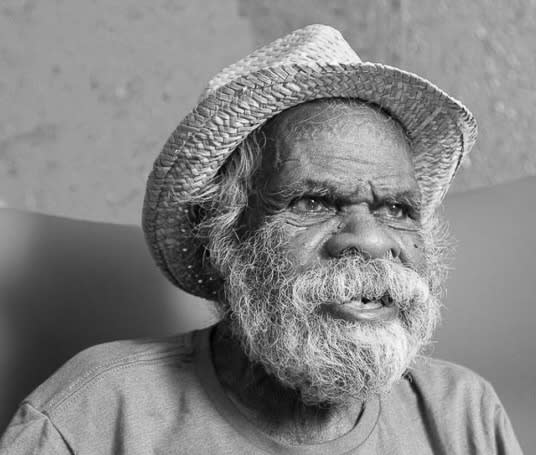Tommy Watson Yannima was a senior Pitjantjatjara elder from the Karimara skin group, born around 1935 at Anamarapiti, just west of the present day community of Irrunytju in Western Australia. He passed away in 2017 in Alice Springs in the Northern Territory.
As a young man Watson learned the bush skills of hunting and gathering, living off the land around Ernabella and further to the Petersham Ranges. In these years his knowledge of the country was deeply embedded with the spiritual and physical meanings of the land. During his twenties, he worked as a stockman in the deserts around Mount Ebenezer, 200 kilometers east of Uluru and then at Yuendumu. He later returned to his homeland at Irrunytju to live a traditional life governed by ceremony and his family’s connection with the land. Here he learned about the Tjukurpa, the creation period, or Dreamtime, in which ancestral beings created the world as we know it. In these stories lie the basis for the religion, law and moral systems of the Australian Aboriginals.
Tommy Watson began his career as an artist quite late in his life, joining the Irrunytju Arts group only in 2002. Soon after exhibiting at the Desert Mob show at Alice Springs later that year, he developed a national and international reputation for his incandescent paintings. Tommy Watson maintained strong links with his traditional lands and sacred sites his whole life. He painted ancestral stories from both his mother’s country south west of Warakurna and his grandfather’s country.
Watson's work has received critical acclaim, both within Australia and internationally, with art critics drawing parallels between Watson and Western Abstract painters such as Wassily Kandinsky, Piet Mondrian, Kasimir Malevich, Mark Rothko and Barnett Newman. John MacDonald wrote in the Sydney Morning Herald that Watson "is a master of invention and arguably the outstanding painter of the Western Desert", going on to compare his use of colour to Henri Matisse.
Artwork and technique
Like Emily Kame Kngwarrreye, Tommy Watson maintains the secrecy of the sacred meanings of his paintings. His paintings might be described in abstract expressionist terms as exploiting a virtual 'geography of sensation’. The colors and abstract shapes are stunningly beautiful. Common subjects in his artworks are rockholes, stream beds and hills or mountains surrounded by waves of light. Many of his paintings resonate light waves or explosions. They are painted in a traditional dotting style.

